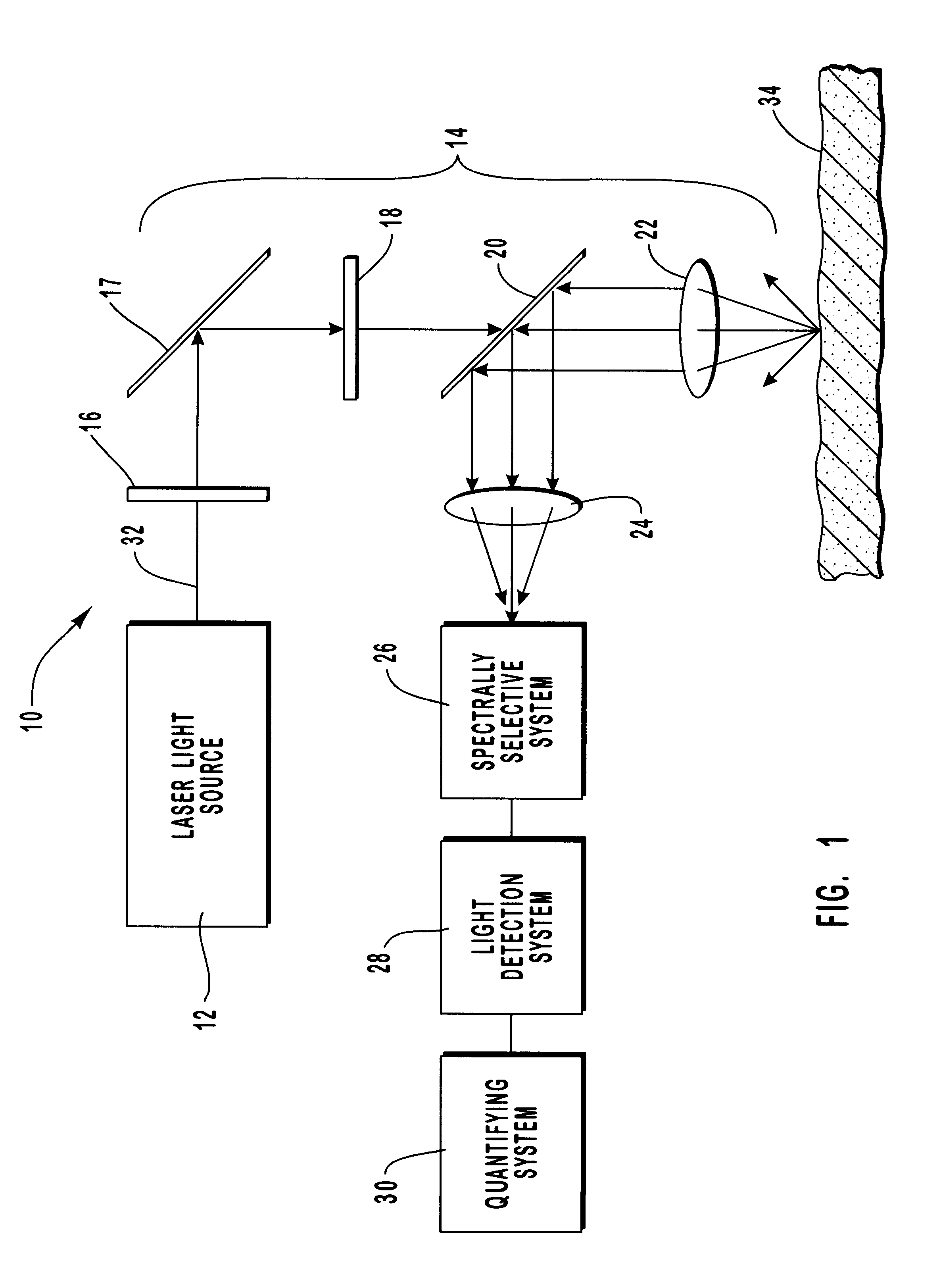Method and apparatus for noninvasive measurement of carotenoids and related chemical substances in biological tissue
a carotenoids and chemical substance technology, applied in the field of methods and equipment for quantitative measurement of carotenoids and related chemical substances in biological tissues, can solve the problems of low carotenoids and related substances such as retinoids as high risk factors for malignant lesions, skin cancer rates continue to rise, and the majority of findings, however, have been somewhat compromised. , to achieve the effect of rapid, noninvasive and quantitative measurement, assessment of the risk of malignancy diseas
- Summary
- Abstract
- Description
- Claims
- Application Information
AI Technical Summary
Benefits of technology
Problems solved by technology
Method used
Image
Examples
example 2
A typical Raman carotenoid spectrum obtained from the skin of a healthy human volunteer with the apparatus of Example 1 is shown in the graph of FIG. 3. A skin spot size of about 2 mm was illuminated with laser light at 488 nm with 10 mW power. The data was plotted in the standard format of photon count (intensity) vs. wavenumber shift. The spectrum was measured using resonance Raman techniques for further enhancement of the inherently weak Raman signal. Raman peaks characteristic of carotenoid molecules appear in the graph of FIG. 3, which are superimposed on a broad fluorescence background. Nevertheless, the Raman peaks are clearly resolved, and, using the high dynamic sensitivity range of the CCD detector, can be displayed with good sensitivity resolution and high signal-to-noise ratio. This is shown for example in FIG. 4, where the fluorescence background has been fitted with a higher order polynomial and subtracted from the spectrum. The background fluorescence spectrum can be ...
example 3
In order to further characterize the fluorescence background and its influence on the Raman measurements of human skin, the fluorescence emission spectra of human skin was measured in vivo for blue / green laser excitation wavelengths of 458 nm, 488 nm, 514.5 nm, and 532 nm. The power density of the laser was 0.2 W / cm.sup.2, and the sampling time per 1 nm wavelength interval was 1 second. The results are shown in the graph of FIG. 5, revealing that the emission consists of at least two broad and overlapping bands, one centered near 600 nm, and the other near 750 nm. With increasing excitation wavelengths, the emission central maxima shift slightly to longer wavelengths, their overall intensities decrease, and at 532 nm excitation only the short wavelength component of the emission is left. The origin of this so called skin "autofluorescence" is due to intrinsic fluorophores, i.e. collagen cells, porphyrin molecules, etc., and not due to carotenoid emission. This conclusion is further ...
example 4
The Raman scattering intensity scales inversely with the fourth power of the excitation wavelength, which in practice, means that it strongly increases with shorter excitation wavelength. On the other hand, the overlapping fluorescence which masks the Raman signal, also increases with shorter wavelength. In the case of resonance Raman scattering, the light scattering efficiency is additionally influenced by the electronic absorption behavior of the scattering species, following in general the spectral dependence of the electronic absorption transition. Therefore, in order to find the optimum excitation conditions for maximum contrast between Raman peaks and fluorescence background, the excitation conditions were varied using five different argon laser lines and a frequency doubled Nd:YAG laser wavelength. The excitation power density was 0.2 W / cm.sup.2, and the sampling time was 10 seconds. The results are given in the graph of FIG. 7, which shows the spectral dependencies for both ...
PUM
 Login to View More
Login to View More Abstract
Description
Claims
Application Information
 Login to View More
Login to View More - R&D
- Intellectual Property
- Life Sciences
- Materials
- Tech Scout
- Unparalleled Data Quality
- Higher Quality Content
- 60% Fewer Hallucinations
Browse by: Latest US Patents, China's latest patents, Technical Efficacy Thesaurus, Application Domain, Technology Topic, Popular Technical Reports.
© 2025 PatSnap. All rights reserved.Legal|Privacy policy|Modern Slavery Act Transparency Statement|Sitemap|About US| Contact US: help@patsnap.com



